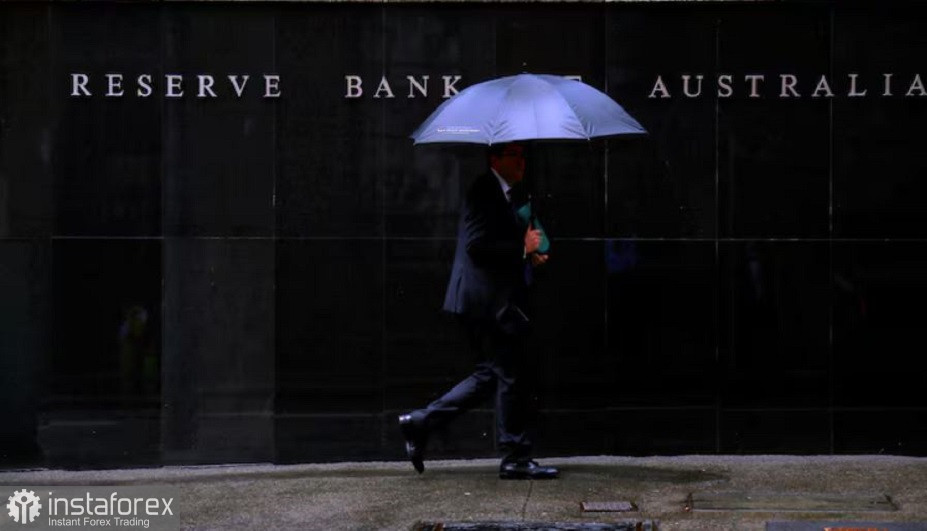During the Asian session on Tuesday, the Reserve Bank of Australia will summarize its latest meeting, which will be held in August. In the lead-up to this event, traders are noticeably nervous: contrary to the dollar's broad weakness, the AUD/USD pair hit a 9-month price low on Monday, marking 0.6350. Looking at the pair's weekly chart, we see that the price has been consistently declining for the fourth consecutive week, reacting to the risk-off sentiments gaining momentum and a series of negative news from China.

After the AUD/USD pair tested its nine-month low on Monday, it rebounded by nearly 100 pips. Traders could not ignore the significant weakness of the greenback. The US dollar index dropped to the base of the 102 figure—its lowest since January. Disappointing Nonfarm Payrolls published Friday intensified dovish market expectations regarding the Federal Reserve's upcoming actions. Confidence increased in the market that the Fed will lower the rate by 50 basis points in September and possibly by another 25 points in November. Such prospects are pulling down the dollar.
However, the bullish corrective rally of AUD/USD is conditioned not only by the greenback's weakness. The "RBA factor" also plays its role, especially in light of Australia's latest inflation data. Recent macroeconomic releases suggest that members of the RBA might toughen their rhetoric at the outcome of the August meeting, which was already relatively hawkish in recent sessions.
The August meeting is significant because it is the first meeting after the release of Australian inflation data for the second quarter. The report was released last week; RBA representatives have yet to comment.
Australia's Consumer Price Index accelerated in the second quarter to 3.8% year-over-year. The index had shown a downward trend for five consecutive quarters, and this was the first growth recorded since late 2022. On a quarterly basis, the CPI remained at the same level as in the first quarter, at 1.0%. However, the pace of core inflation growth was below forecasts. The trimmed mean increased by 0.8%, against forecasts of a 1.0% rise. On an annual basis, this measure slowed to 3.9% (the previous value was 4.0%), marking the weakest growth rate since early 2022.
How the members of the central bank will assess this data is unknown. There is no consensus here. According to some analysts, the slowdown in the Trimmed Mean CPI will allow the RBA to maintain a wait-and-see position and even soften its rhetoric. According to other experts, the RBA will be concerned about the rise in inflation.
Strong data in the Australian labor market allow the central bank to maintain a wait-and-see position and even contemplate raising the interest rate. According to the latest data, employment in the country increased by 50,000, with a forecast increase of 20,000 (the July result is the strongest since February this year). Importantly, the employment growth was exclusively due to an increase in full-time employment: part-time employment rose by only 6,800, while full-time employment increased by 43,000.
In my opinion, the RBA will keep all parameters unchanged after its August meeting, will be concerned about the overall inflation rise, and will refrain from hawkish signals. In the current conditions, additional turbulence is absolutely unnecessary for the central bank. The markets are already experiencing a strong storm due to fears of a recession in the US. And it seems that the storm will not subside tomorrow. The US stock market opened with a sharp decline, losing $1.93 trillion at the opening of trading. All major companies depreciated—Google, Apple, Microsoft, Tesla, Nvidia, and Amazon. The Nasdaq index plunged by 6%, the Dow Jones fell almost 3%, and the S&P 500 by 4%. The Nikkei 225 index crashed almost by 13%, marking the largest single-day fall in its history.
The disappointing July Nonfarm Payrolls have raised concerns that the Fed waited too long to begin lowering interest rates (and, as they say, "waited too long").
In such turbulent conditions, the RBA is unlikely to make abrupt statements, especially since the Trimmed Mean CPI has slowed down, allowing the central bank to avoid any drastic actions for now.
If the market turmoil does not subside (and it likely will not), traders of AUD/USD will ignore the inconsequential outcomes of the RBA's August meeting. Here, they will find themselves in a difficult situation: on the one hand, the US dollar's broad weakness, and on the other, rising risk-averse sentiments (which weakens the Australian dollar as well). The aussie is caught between a rock and a hard place. In such fundamentally uncertain conditions, staying out of the market is most sensible: the AUD/USD pair will likely exhibit high volatility. However, it will not be able to determine a clear direction for price movement.





















